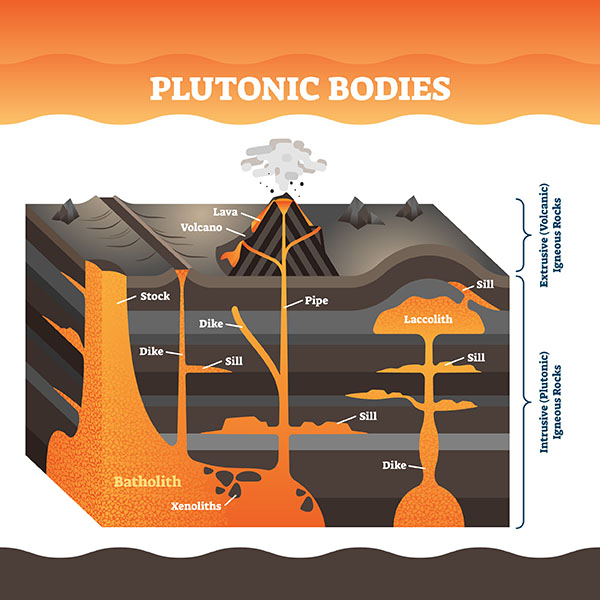
< Back
intrusive igneous rock
Definition
Intrusive igneous rocks are rocks that form when magma cools and solidifies within the Earth's crust. They are the opposite of extrusive igneous rocks, which form when magma cools and solidifies on the surface of the Earth.
Intrusive igneous rocks are formed when magma is forced into cracks and pockets in the Earth's crust. As the magma cools, it forms large crystals. This is because the magma has more time to cool slowly when it is underground.
Intrusive igneous rocks are classified based on their texture, which is determined by the size of the crystals in the rock. The three main types of intrusive igneous rocks are:
- Phanerocrystic rocks: These rocks have large crystals that can be seen with the naked eye.
- Porphyritic rocks: These rocks have large crystals (phenocrysts) embedded in a finer-grained matrix.
- Aphanitic rocks: These rocks have no visible crystals.
Intrusive igneous rocks are an important part of the Earth's crust. They form mountains, volcanoes, and other landforms. They also provide us with valuable resources, such as granite and marble.
How can the word be used?
The granite found in the Sierra Nevada mountains is an example of an intrusive igneous rock.

Different forms of the word
There are no different forms of the word "intrusive igneous rock". It is a compound noun that refers to a type of igneous rock that forms when magma cools and solidifies within the crust of the Earth.
Etymology
The word "intrusive" comes from the Latin word "intrusīvus", which means "thrusting in". This is a reference to the way that intrusive igneous rocks are formed, when magma forces its way into cracks and spaces in the Earth's crust.
The word "igneous" comes from the Latin word "ignis", which means "fire". This is a reference to the fact that intrusive igneous rocks are formed from magma, which is molten rock that has risen from the Earth's mantle.
So, the term "intrusive igneous rock" literally means "rock that is thrust in by fire". This is a very accurate description of how these rocks are formed.
Question
What is intrusive igneous rock?
AQA Science Exam Question and Answer
Question:
Explain the formation and characteristics of intrusive igneous rocks, detailing the process of their slow cooling and crystallization beneath the Earth's surface. Provide examples of common intrusive igneous rocks and discuss their significance in understanding Earth's geological history.
Answer:
Intrusive igneous rocks, also known as plutonic rocks, are formed through the slow cooling and crystallization of magma beneath the Earth's surface. As magma rises from the mantle and solidifies within the crust, it forms large mineral crystals due to the extended cooling period.
The slow cooling of intrusive rocks allows mineral crystals to grow to a visible size, resulting in a coarse-grained texture. Granite is a classic example of an intrusive igneous rock, characterised by its interlocking crystals of quartz, feldspar, and mica. Another example is diorite, which exhibits similar mineral composition but with different proportions.
These rocks provide valuable insights into Earth's geological history. Their presence indicates ancient volcanic activity and can help determine the depth and temperature of magma chambers during their formation. The study of intrusive igneous rocks has contributed to our understanding of plate tectonics, the movement of continents, and the evolution of mountain ranges.
Intrusive igneous rocks have practical uses as well. Granite, for instance, is often used as a building material due to its durability and aesthetic appeal. Understanding their formation and characteristics helps geologists unravel the Earth's past and aids in various fields, from construction to deciphering geological processes.